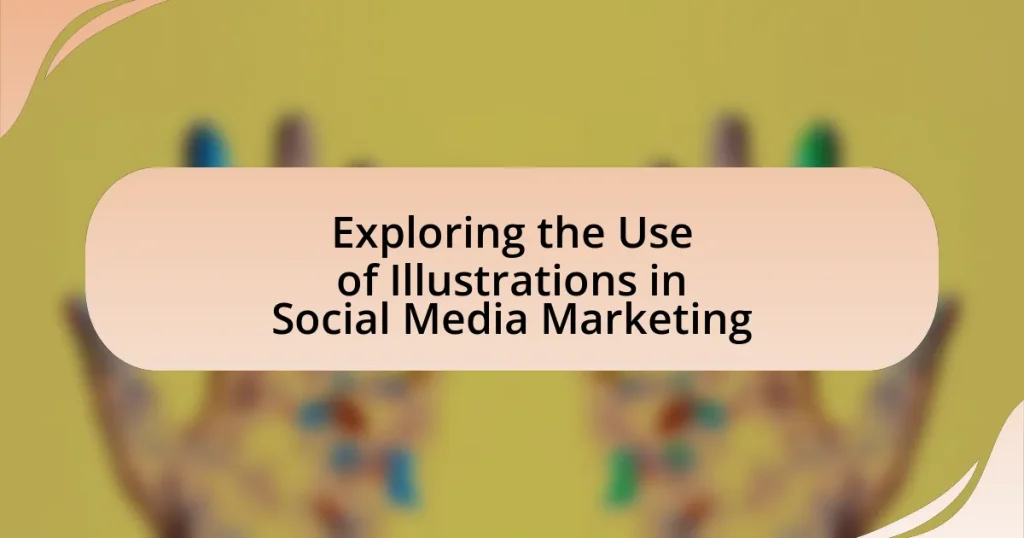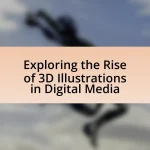The article focuses on the use of illustrations in social media marketing, highlighting their role as visual representations that enhance brand messaging and engagement. It discusses how illustrations capture attention, simplify complex ideas, and evoke emotional responses, significantly increasing user interaction and retention. The article outlines various types of illustrations commonly used, such as infographics and vector graphics, and compares their effectiveness to photographs. Additionally, it addresses the importance of illustrations for brand identity, recognition, and conveying brand values, while providing practical tips for businesses to effectively incorporate illustrations into their social media strategies. Challenges and future trends in the use of illustrations are also examined, emphasizing the impact of technology and emerging styles on marketing practices.
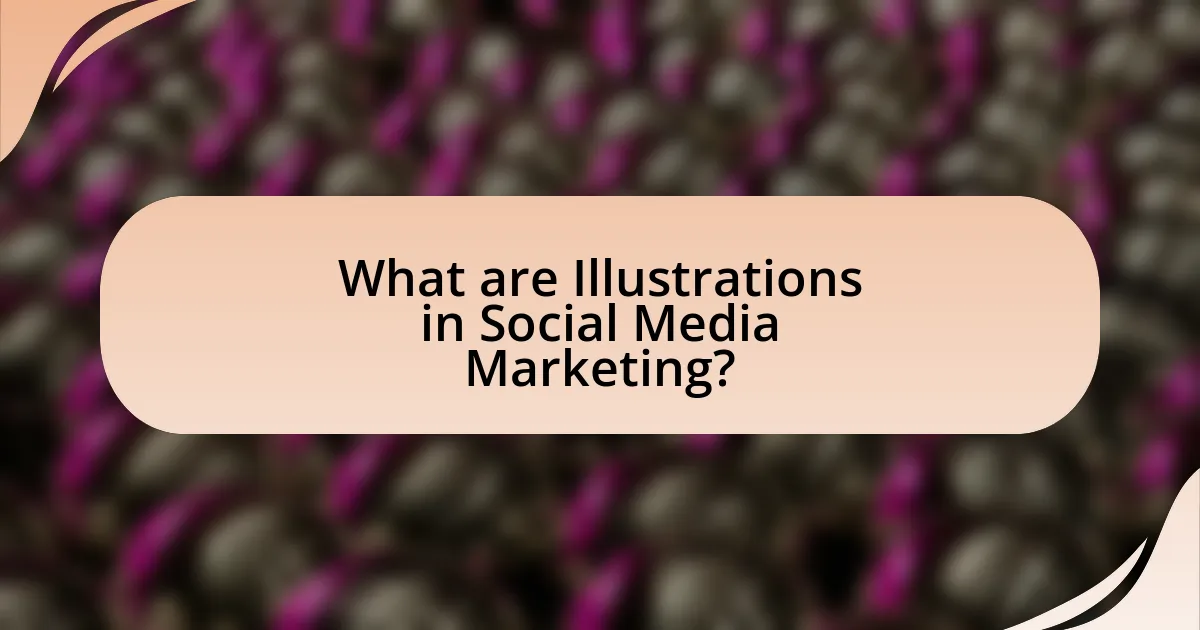
What are Illustrations in Social Media Marketing?
Illustrations in social media marketing are visual representations, such as drawings or graphics, used to enhance brand messaging and engagement. These illustrations serve to capture attention, convey complex ideas quickly, and evoke emotional responses from the audience. Research indicates that visual content is processed 60,000 times faster than text, making illustrations a powerful tool for increasing user interaction and retention on social media platforms.
How do illustrations enhance social media content?
Illustrations enhance social media content by increasing engagement and improving message retention. Visual elements, such as illustrations, capture attention more effectively than text alone; studies show that posts with images receive 94% more views than those without. Furthermore, illustrations can simplify complex ideas, making them more accessible and memorable for audiences. This is supported by research from the University of Pennsylvania, which found that visual aids can improve learning and retention by up to 400%. Thus, incorporating illustrations into social media content not only attracts viewers but also aids in conveying information clearly and effectively.
What types of illustrations are commonly used in social media marketing?
Common types of illustrations used in social media marketing include infographics, vector graphics, and hand-drawn illustrations. Infographics effectively convey complex information visually, making them popular for sharing data and statistics. Vector graphics are favored for their scalability and clean lines, which enhance brand identity across various platforms. Hand-drawn illustrations add a personal touch, fostering engagement and relatability with audiences. These types of illustrations are chosen based on their ability to capture attention, convey messages clearly, and align with brand aesthetics.
How do illustrations differ from photographs in social media marketing?
Illustrations differ from photographs in social media marketing primarily in their ability to convey abstract concepts and emotions creatively. While photographs capture real-life moments and provide authenticity, illustrations allow for stylization and personalization, enabling brands to express unique identities and messages. For instance, a study by the Content Marketing Institute found that visual content, including illustrations, can increase engagement rates by up to 94%, highlighting their effectiveness in capturing audience attention compared to traditional photographs. This distinction makes illustrations particularly valuable for brands aiming to differentiate themselves in a crowded digital landscape.
Why are illustrations important for brand identity?
Illustrations are important for brand identity because they create a visual representation that distinguishes a brand from its competitors. This unique visual identity helps consumers recognize and remember the brand, fostering brand loyalty. Research indicates that visuals can increase engagement by up to 94%, as they capture attention more effectively than text alone. Furthermore, illustrations can convey complex ideas quickly and evoke emotions, enhancing the overall brand message. This effectiveness in communication and memorability underscores the critical role illustrations play in establishing and maintaining a strong brand identity.
How do illustrations contribute to brand recognition?
Illustrations significantly enhance brand recognition by creating a unique visual identity that distinguishes a brand from its competitors. This distinctiveness is achieved through consistent use of specific styles, colors, and themes in illustrations, which helps consumers easily associate these visuals with the brand. Research indicates that visuals are processed 60,000 times faster than text, making illustrations a powerful tool for capturing attention and conveying messages quickly. Furthermore, brands that utilize illustrations effectively can increase their memorability; a study by the University of California found that people remember illustrated content 65% better than text alone. This combination of unique visual identity and improved recall solidifies a brand’s presence in the minds of consumers, ultimately contributing to stronger brand recognition.
What role do illustrations play in conveying brand values?
Illustrations play a crucial role in conveying brand values by visually representing the essence and personality of a brand. They create an immediate emotional connection with the audience, making complex ideas more accessible and relatable. For instance, brands like Airbnb use illustrations to depict inclusivity and community, reinforcing their core values of belonging and connection. Research indicates that visual content is processed 60,000 times faster than text, highlighting the effectiveness of illustrations in communicating brand messages quickly and memorably.
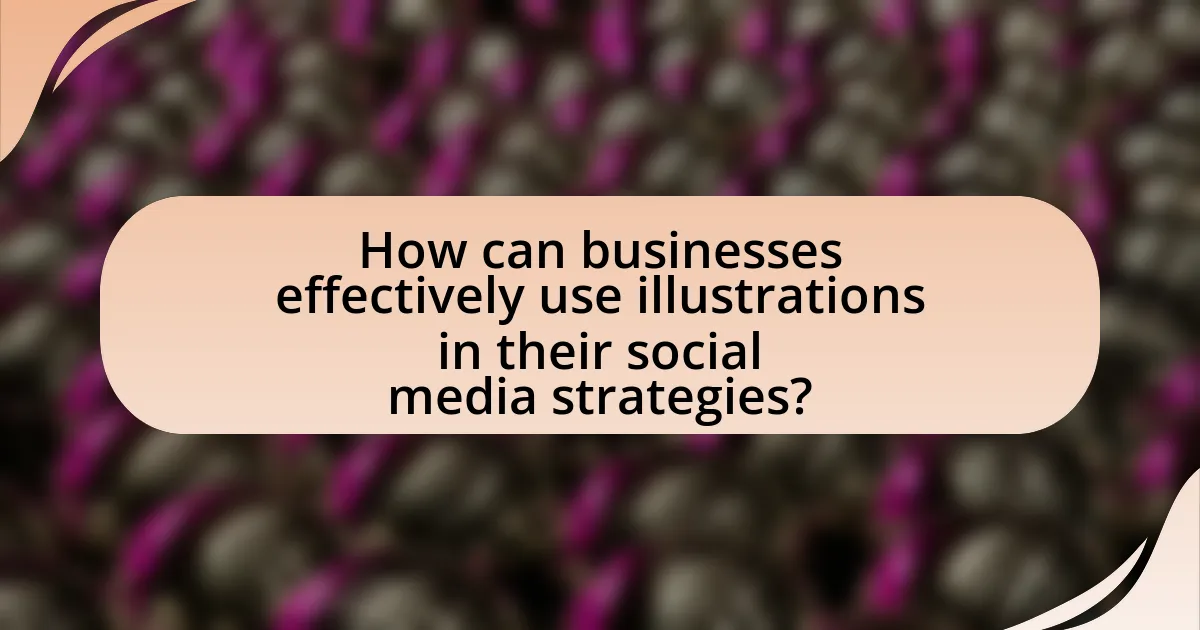
How can businesses effectively use illustrations in their social media strategies?
Businesses can effectively use illustrations in their social media strategies by creating visually engaging content that enhances brand storytelling and captures audience attention. Illustrations can simplify complex ideas, making them more accessible and shareable, which is crucial in a fast-paced social media environment. For instance, a study by Venngage found that posts with visuals receive 94% more views than those without, highlighting the importance of incorporating illustrations to boost engagement. Additionally, using consistent illustration styles can strengthen brand identity, as seen with companies like Dropbox, which utilizes unique illustrations to convey its brand message effectively.
What are the best practices for creating engaging illustrations?
The best practices for creating engaging illustrations include using a clear focal point, maintaining a cohesive color palette, and ensuring relevance to the target audience. A clear focal point directs viewers’ attention and enhances understanding, while a cohesive color palette creates visual harmony and brand recognition. Additionally, illustrations should resonate with the audience’s interests and preferences, which can be determined through market research and audience analysis. Research indicates that visuals can increase engagement rates on social media by up to 650%, highlighting the importance of effective illustration in marketing strategies.
How can color psychology influence the effectiveness of illustrations?
Color psychology significantly influences the effectiveness of illustrations by evoking specific emotions and associations that can enhance audience engagement. For instance, warm colors like red and orange can create feelings of excitement and urgency, making them effective for calls to action in marketing illustrations. Conversely, cool colors such as blue and green often convey calmness and trust, which can be beneficial for brands aiming to establish credibility. Research indicates that color can increase brand recognition by up to 80%, demonstrating its critical role in visual communication. Therefore, understanding and applying color psychology in illustrations can lead to more impactful and persuasive marketing strategies.
What tools and software are recommended for creating illustrations?
Adobe Illustrator is a highly recommended tool for creating illustrations due to its extensive vector graphic capabilities, which allow for scalable designs without loss of quality. Additionally, Procreate is favored among digital artists for its intuitive interface and robust brush engine, making it ideal for illustrations on iPad. Furthermore, CorelDRAW offers a comprehensive suite for vector illustration and layout, appealing to both beginners and professionals. These tools are widely used in the industry, with Adobe Illustrator holding a significant market share of 40% among graphic design software, indicating its popularity and reliability for illustration work.
How can businesses measure the impact of illustrations on social media engagement?
Businesses can measure the impact of illustrations on social media engagement by analyzing metrics such as likes, shares, comments, and overall reach of posts containing illustrations. These metrics provide quantitative data that reflects audience interaction and interest levels. For instance, a study by HubSpot found that visual content is 40 times more likely to be shared on social media than other types of content, indicating that illustrations can significantly enhance engagement. Additionally, tools like Google Analytics and social media insights can track user behavior and engagement patterns, allowing businesses to correlate specific illustrations with spikes in engagement metrics.
What metrics should be tracked to evaluate illustration effectiveness?
To evaluate illustration effectiveness in social media marketing, key metrics include engagement rate, click-through rate (CTR), conversion rate, and reach. Engagement rate measures interactions (likes, shares, comments) relative to impressions, indicating how well the illustration resonates with the audience. Click-through rate assesses the percentage of users who click on a link associated with the illustration, reflecting its ability to drive traffic. Conversion rate tracks the percentage of users who complete a desired action after interacting with the illustration, demonstrating its effectiveness in achieving marketing goals. Reach quantifies the total number of unique users who see the illustration, providing insight into its visibility and potential impact. These metrics collectively offer a comprehensive view of an illustration’s performance in social media contexts.
How can A/B testing be utilized with illustrations in social media posts?
A/B testing can be utilized with illustrations in social media posts by comparing two different versions of a post to determine which illustration resonates more with the audience. For instance, a brand can create two posts featuring different illustrations and measure engagement metrics such as likes, shares, and comments. Research indicates that posts with visually appealing illustrations can increase engagement rates by up to 94%, highlighting the importance of effective visual content. By analyzing the performance of each version, marketers can identify which illustration leads to higher audience interaction, thereby optimizing future content strategies.
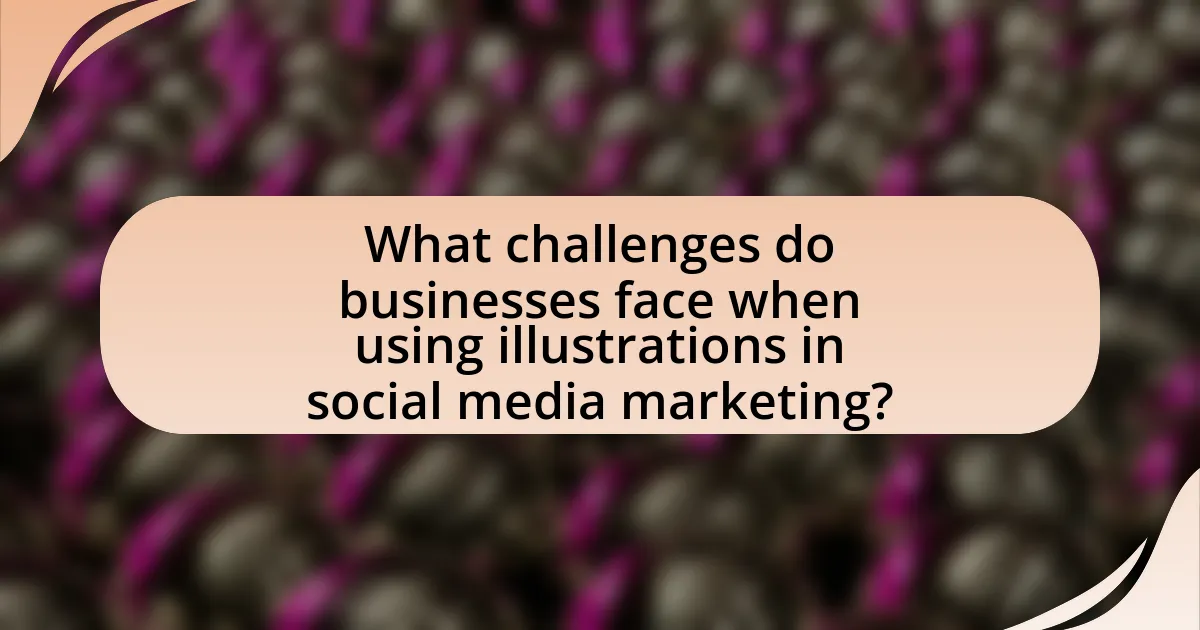
What challenges do businesses face when using illustrations in social media marketing?
Businesses face several challenges when using illustrations in social media marketing, primarily related to audience engagement, brand consistency, and copyright issues. Engaging the target audience can be difficult, as illustrations must resonate with diverse demographics and preferences, which requires thorough market research and understanding of visual trends. Maintaining brand consistency is another challenge, as businesses need to ensure that illustrations align with their overall brand identity and messaging, which can be complex when working with multiple platforms and formats. Additionally, copyright issues pose significant risks; businesses must navigate the legal landscape of using illustrations, ensuring they have the right to use images and avoiding potential infringement, which can lead to costly legal disputes.
How can businesses overcome common obstacles in illustration use?
Businesses can overcome common obstacles in illustration use by investing in professional design resources and establishing clear guidelines for visual content. Professional designers can create high-quality illustrations that align with brand identity, ensuring consistency and appeal. Additionally, setting guidelines helps streamline the illustration process, making it easier to maintain a cohesive visual strategy across social media platforms. Research indicates that consistent branding can increase revenue by up to 23%, highlighting the importance of effective illustration use in marketing efforts.
What are the potential pitfalls of using illustrations in social media?
The potential pitfalls of using illustrations in social media include misinterpretation, brand inconsistency, and copyright issues. Misinterpretation can occur when the audience does not understand the intended message of the illustration, leading to confusion or negative perceptions. Brand inconsistency arises when illustrations do not align with the established brand identity, which can dilute brand recognition and trust. Copyright issues may arise if illustrations are used without proper licensing or attribution, potentially resulting in legal consequences. These pitfalls highlight the importance of careful consideration and strategic planning when incorporating illustrations into social media marketing.
How can businesses ensure their illustrations are culturally sensitive?
Businesses can ensure their illustrations are culturally sensitive by conducting thorough research on the cultural contexts of their target audiences. This involves understanding cultural symbols, values, and norms to avoid misrepresentation or offense. For instance, a study by the Pew Research Center highlights that cultural awareness can significantly impact audience engagement and brand perception. By collaborating with cultural consultants or diverse teams, businesses can gain insights that help create illustrations that resonate positively with various cultural groups.
What are the future trends in the use of illustrations for social media marketing?
Future trends in the use of illustrations for social media marketing include increased personalization, the rise of animated and interactive content, and a focus on sustainability. Personalization allows brands to create tailored illustrations that resonate with specific audience segments, enhancing engagement. Animated and interactive illustrations are gaining traction as they capture attention more effectively than static images, with studies showing that animated content can increase click-through rates by up to 300%. Additionally, brands are increasingly adopting eco-friendly practices in their illustrations, reflecting consumer demand for sustainability; for instance, 66% of global consumers are willing to pay more for sustainable brands. These trends indicate a shift towards more engaging, relevant, and responsible visual content in social media marketing.
How is technology shaping the evolution of illustrations in marketing?
Technology is significantly shaping the evolution of illustrations in marketing by enabling more dynamic, interactive, and personalized visual content. Advances in digital tools and software allow marketers to create high-quality illustrations that can be easily adapted for various platforms, enhancing engagement. For instance, the rise of augmented reality (AR) and virtual reality (VR) technologies has transformed static illustrations into immersive experiences, allowing consumers to interact with products in a virtual space. Additionally, data analytics tools enable marketers to tailor illustrations based on consumer preferences and behaviors, leading to more effective targeting. According to a report by HubSpot, 65% of marketers believe that visual content is essential for their marketing strategy, highlighting the growing importance of technology in creating impactful illustrations.
What emerging styles of illustrations are gaining popularity in social media?
Emerging styles of illustrations gaining popularity in social media include minimalistic designs, hand-drawn aesthetics, and 3D illustrations. Minimalistic designs focus on simplicity and clarity, making them visually appealing and easy to digest, which aligns with the fast-paced nature of social media consumption. Hand-drawn aesthetics evoke a sense of authenticity and personal touch, resonating with audiences seeking relatable content. 3D illustrations, on the other hand, provide depth and engagement, often used in animated formats to capture attention. These styles reflect current trends in user preferences for visually striking and emotionally engaging content.
What practical tips can businesses implement for effective illustration use in social media marketing?
Businesses can implement several practical tips for effective illustration use in social media marketing. First, they should ensure that illustrations align with their brand identity, as consistent visual elements enhance brand recognition. For instance, using a specific color palette or style can create a cohesive look across platforms. Second, businesses should utilize high-quality illustrations that are visually appealing and relevant to their target audience, as studies show that engaging visuals can increase user interaction by up to 94%. Third, incorporating illustrations that tell a story can enhance emotional connection, making content more relatable and shareable. Additionally, businesses should optimize illustrations for different social media platforms, considering size and format specifications to ensure clarity and impact. Finally, leveraging user-generated illustrations can foster community engagement and authenticity, as consumers often trust peer-created content more than brand-generated visuals.
